
Jessica Irvine has continued her good run of form in a post today on Business Spectator asking whether yesterday’s economy is as good as it gets?
…a budget storm is brewing and I wonder if the Australian people realise yet that last night, today even, is as good as it gets.
Having mostly avoided the fallout from the global financial crisis, sheltered by the economic cocoon of a mining boom, reality is about to catch up with us.
Australians are about to see a decline in their real living standards. As the economy slows out of the mining boom, we can expect to see the economy and wages grow at a below trend rate. Inflation will likely remain subdued, eating a little less out of pay packets.
But government is – if politicians follow the advice of economists – about to take a chunk.
Having funnelled money into people’s pocket during the good times, with personal income tax cuts, stimulus cheques, one-off bonuses and household compensation – governments will need to curb their enthusiasm during the not-as-good times.
Everything that was given must now be taken back. It wasn’t the politicians’ to share in the first place. The one-off proceeds of the boom should never have been built into permanent and ongoing personal income tax cuts of the magnitude that were given.
Our tax base has been denuded. And it’s time to regain some fiscal fig of budget prudence…Australians are going to have to pay more tax than they’ve got used to or get used to shoddier services.
Either way, we will see a decline in real living standards of a similar magnitude to the gains of recent years.
Bravo. The challenges Ms Irvine is talking about can best be summarised by the below chart from the Australian Treasury showing the unwinding of the commodity price boom (read falling terms-of-trade) and the ageing of the population, as measured by a declining share of workers to dependents:
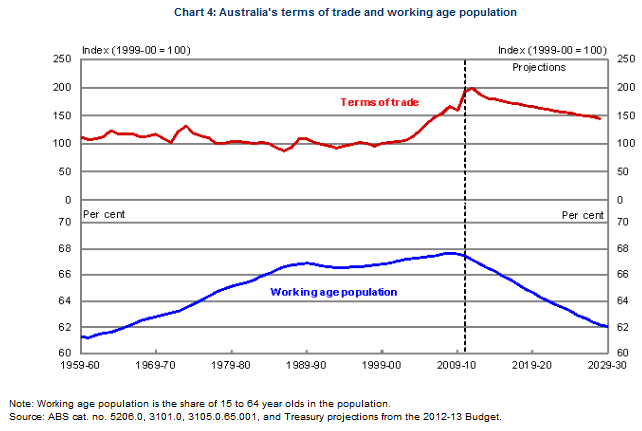
As noted many times previously, the sharp rise in the value of Australia’s export commodities – in particular iron ore and coal – since 2003 meant that Australia received a pay rise, since more imports could be bought with a given volume of exports. In turn, real (inflation-adjusted) average personal disposable incomes rose at a much faster rate than justified by the growth of the Australian economy, as measured by real per capita GDP (see below charts).
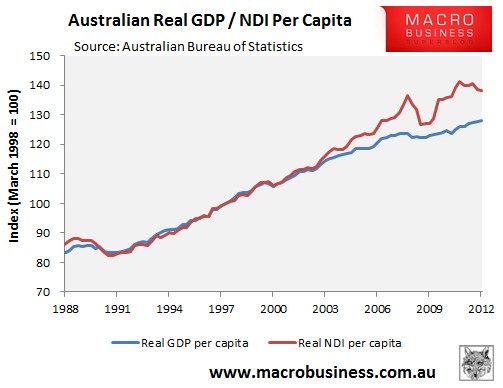
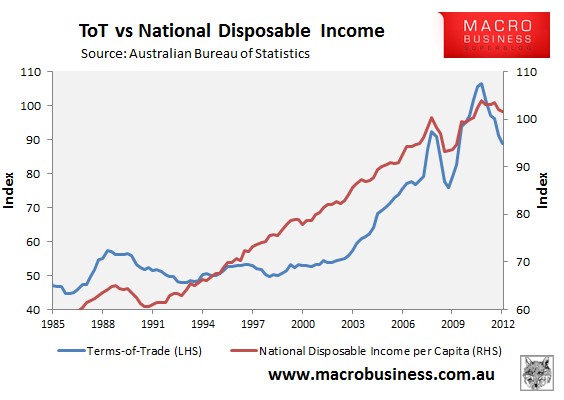
In fact, research released last year by the Australian Treasury showed that around half of the growth of average incomes experienced over the 2000s was caused by the one-off rise in the terms-of-trade (commodity prices):
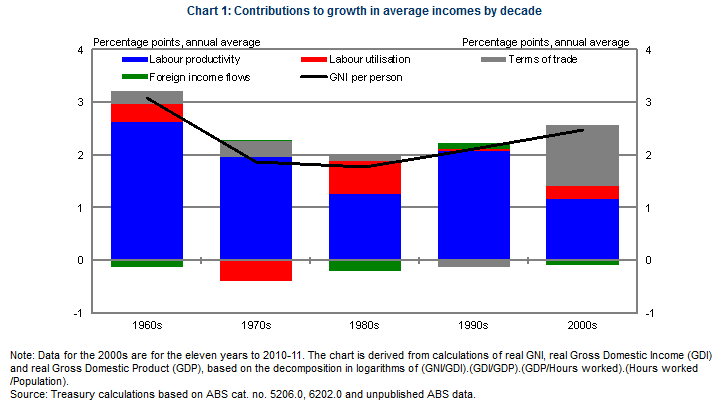
The sharp rise in commodity prices also underpinned government budgets, which reaped the benefit of rising personal and company taxes, as well as resource rent taxes. Some of this extra taxation revenue was also re-distributed to households via tax cuts and welfare payments, thereby further inflating disposable incomes.
The problem for Australia is that the terms-of-trade are now falling, which is dragging heavily on income growth, with real per capital national disposable income falling by -0.5% over the December quarter and by -1.4% over the past year. Going forward, income growth will continue to be weak as long as the terms-of-trade continues to unwind.
To add insult to industry, mining related capital expenditures (capex), which have more than doubled over the past two years to 6.6% of GDP, are expected to peak later this year, further dragging on incomes, growth and employment (see next chart).
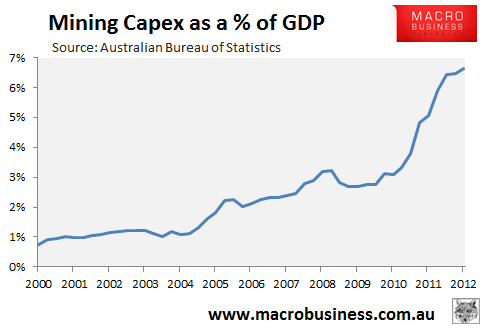
While the commodity boom has provided strong support to the Australian economy over the past decade, the best has past. With the terms-of-trade now falling and mining-related capex expected to peak and then decline later this year, Australia faces a prolonged period of below average income growth, lower employment growth, and budgetary pressures, at the same time as pressures from an ageing population are building.
The bigger risk is that the downturn in commodity prices accelerates, brought about by a slowing Chinese economy and/or an increase in global commodity supplies. In this event, Australia could face a severe reduction in incomes, jobs and government revenues as the terms-of-trade deteriorates and planned mining investments are cancelled.
A sharp decline in both commodity prices and mining investment remains the nightmare scenario facing the Australian economy.

